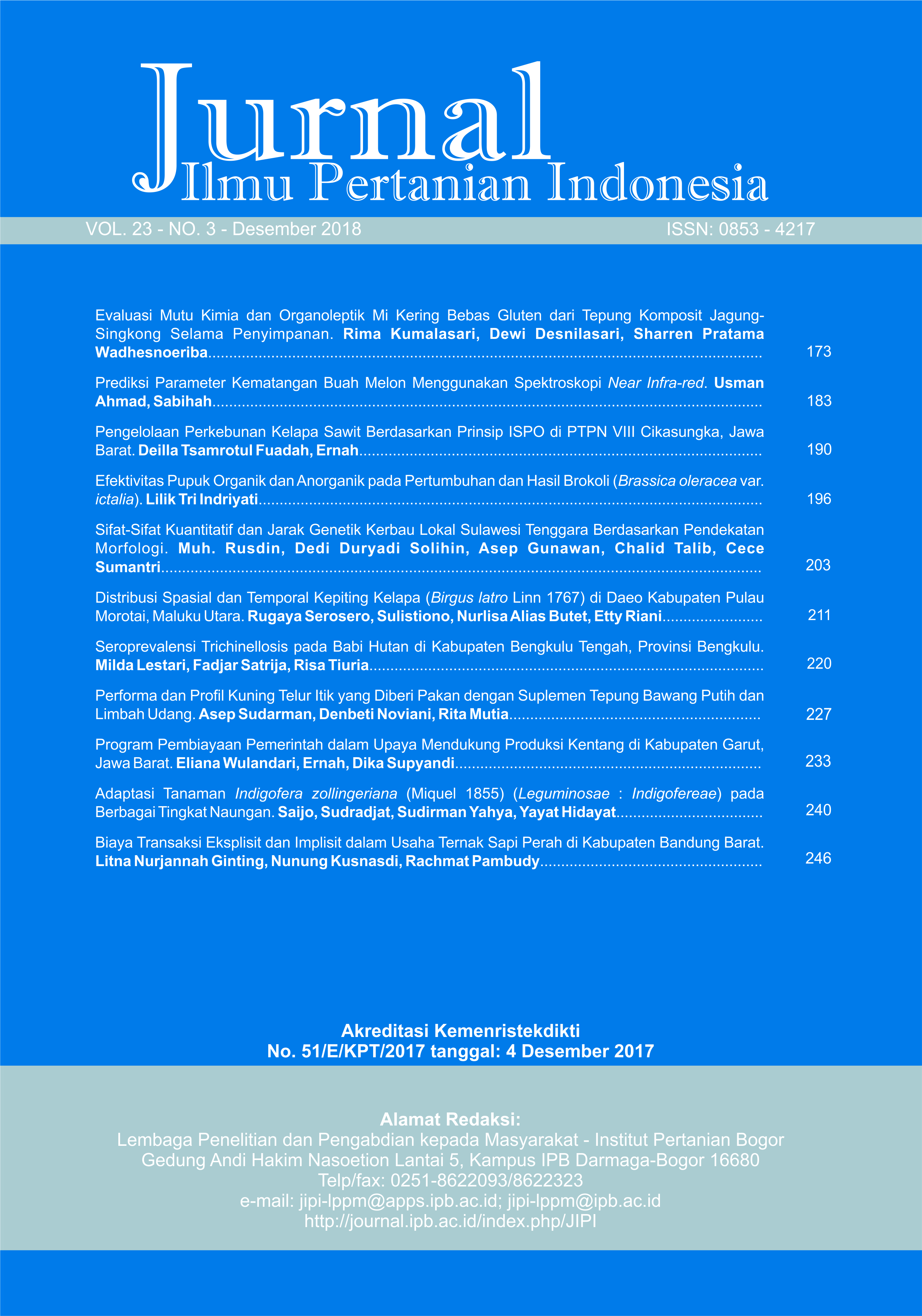Adaptasi Tanaman Indigofera zollingeriana (Miquel 1855) (Leguminosae : Indigofereae) pada Berbagai Tingkat Naungan
Abstract
Indigofera zollingeriana is a bush type legume plant that grows well in full light but tolerant to shade conditions. Modification efforts of the environment with paranet shade treatment are the accurate approach. The objective of this research was to study the tolerance limit of I. zollingeriana plant at various shade levels. The study was conducted in October 2016-April 2017 at the Leuwikopo-IPB Bogor and used randomized block design with one shade factor (0, 40, 65, and 80%). The results of the measurement of microclimate with various shading levels showed that in the shade treatment 40%, the intensity of light decreased by 40% the temperature decreased by 6%, while the humidity increased by 10%. In the 65% shade, the light intensity decreased by 62%, the temperature decreased by 10%, while the humidity increased by 24%. In the 80% shade, the light intensity decreases 95%, the temperature decreases 13%, while the humidity increases 34%. The shade intensity has a real significant on decreasing stem diameter, number of branches, canopy dry weight, and roots. I. zollingeriana is rather tolerant of shade and it is able to adapt to shade up to 40%.
Downloads
References
Abdullah L. 2010. Herbage production and quality of shrub Indigofera treated by different concentration of foliar fertilizer. Media Peternakan. 33: 169-175. https://doi.org/10.5398/medpet.2010.33.3.169
Asadi B, Arsyad, Zahara H, dan Darmijati. 1997. Pemuliaan kedelai untuk toleran naungan. Buletin Agrobio. 1997. 1(2): 15–20.
Das DK, Chaturvedi OP, Mandal MP, Kumar R. 2008. Effect of tree plantations on biomass and primary productivity of herbaceous vegetation in eastern India. Journal of Tropical Ecology. 49: 95-101.
Dwidjoseputro D. 1980. Pengantar fisiologi tumbuhan. Jakarta (ID): Gramedia.
Fischer RA, Maurer R. 1978. Drought resistence in spring wheat cultivars. Australian Journal of Agricultural Research. 29: 897-912. https://doi.org/10.1071/AR9780897
Gardner FP, Pearce RB, Mitchell RL. 1991. Fisiologi Tanaman Budi daya. Jakarta (ID): UI Press. Hal. 212-213.
Hassen A, Rethman NFG, Apostolides WAZ, van Niekerk WA. 2008. Forage production and potential nutritive value of 24 shrubby Indigofera accessions under field conditions in South Africa.Tropical Grasslands. 42: 96-103.
Hassen A, Van Niekerk WA, Rethman NFG, Tjelele TJ. 2006. Intake and in vivo digestibility of indigofera forage compared to medicago sativa and leucaena leucocephala by sheep. South African Journal.International Animals. 36: 67-70.
Hassen A, Rethman NFG, Van Niekerk WA, Tjelele TJ. 2007. Influence of season/year and species on chemical composition and in vitro digestibility of five Indigofera accession. Journal of Animal Feed Science and Technology. 136: 312-322. https://doi.org/10.1016/j.anifeedsci.2006.09.010
Hopkins WG. 1995. Introduction to Plant Physiology, 4th Edition. New York, Toronto, Singapore: John Wiley dan Sons, Inc. pp. 285-321.
Minolta K. 1989. Chlorophyll Meter SPAD-502 Manual Book. Japan (JP): Konica Minolta.
Morais H, Medri ME. Marur CJ, Caramori PH, Riberio AMDA, Gomes JC. 2004. Modifications on leaf anatomy of coffea arabica caused by shade of pigeonpea (Cajanus cajan). Brazilian Archives of Biology and Technology. 47(6): 863-871. https://doi.org/10.1590/S1516-89132004000600005
Musyarofah N, Susanto S, Aziz SA, Kartosoewarno S. 2007. Respons tanaman pegagan (Centella asiatica L. Urban) terhadap pemberian pupuk alami di bawah naungan. Buletin Agronomi. 35(3): 217-224.
Muzayyinah 2012. Jejak Evolusi dan Spesiasi Marga Indigofera. Bioedukasi. Program Studi Pendidikan Biologi Universitas Sebelas Maret. 5(2): 1-12.
Salisbury FB, Ross CW. 1995. Fisiologi Tumbuhan. Jilid 1. Lukman D.R. Sumaryono Penerjemah. Bandung (ID): ITB Press. Terjemahan dari: Phisiology.
Schrire BD. 2005. Tribe Indigofera sp.e. In: Marquiafa´vela, FS, Ferreirab MDS, Teixeiraa SP. Novel reports of glands in Neotropical species of Indigofera sp. L. (Leguminosae, Papilionoideae). Flora. 204: 189-197.
Snyman HA. 2004. Effect of various water application strategis on root development of Opuntia ficus-indica and O. robusta under greenhouse growth condition. Journal of the Professional Association for Cactus Development. 6: 31-61.
Soverda N, Hermawati T. 2009. Respons tanaman kedelai (Glycine max L. Merill) terhadap pemberian berbagai konsentrasi pupuk hayati. Jurnal Agronomi. 13(1): 6-11.
Suradinata YR, Rahman R, Hamdan JS. 2013. Paclobutrazol application and shading levels effect to the growth and quality of Begonia (Begonia rex-cultorum) cultivar Marmaduke. Asian Journal of Agriculture and Rural Development. 3(8): 566-575.
This journal is published under the terms of the Creative Commons Attribution-NonCommercial 4.0 International License. Authors who publish with this journal agree to the following terms: Authors retain copyright and grant the journal right of first publication with the work simultaneously licensed under a Creative Commons Attribution-NonCommercial 4.0 International License. Attribution — You must give appropriate credit, provide a link to the license, and indicate if changes were made. You may do so in any reasonable manner, but not in any way that suggests the licensor endorses you or your use. NonCommercial — You may not use the material for commercial purposes.























